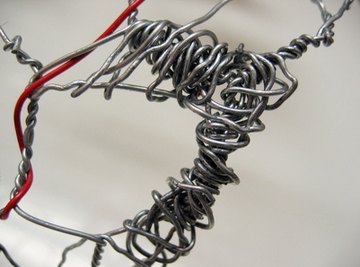
Anodization is the process of growing an oxide layer on top of a metal surface using chemicals and electricity. The oxide layer changes the metal's color to any number of colors or color combinations. This treatment works on several types of metals including aluminum and silver. Aluminum copper alloys are the only kind of copper that can be anodized. Create custom metals at home using materials easily found at the hardware store.
- Dish soap
- Hot water
- Degreaser
- Desmut solution
- Distilled water
- Sulfuric acid
- Large container (plastic or glass)
- Battery charger with positive and negative cathodes
- Rubber gloves
Use dye specifically made for anodized aluminum to add even more color
Always use gloves when working with the chemicals. Work in a well-ventilated area. Use baking soda to clean up any spills.
Clean the metal thoroughly. Dirt or grease mars the surface when anodized. Use dish soap and hot water to clean the metal. Follow with a degreaser. When the metal is sufficiently clean, water runs off it and does not form beads. Repeat the cleaning until water runs off the metal in sheets.
Use a desmut cleaner to remove any other impurities. This is particularly important for aluminum coppery alloy. Desmut cleaners are specifically designed for anodizing. Follow the package instructions to create the desmut solution. Dip the metal in the solution for one to four minutes. The longer the metal is in the solution, the duller the finish will be. For a shiny finish remove the metal after a minute or two. Rinse thoroughly with distilled water.
Prepare the acid bath by mixing one part water to one part distilled water. Use enough solution to cover the metal piece. Add the acid to the water. Do not add the water to the acid. Work in a well-ventilated area, preferably outside.
Submerge the metal into the solution. Ensure it does not touch any of the edges and that it doesn't have any air bubbles underneath it.
Submerge the negative cathode into one end of the container. Do not touch the wall or bottom of the container. Attach the positive cathode to the metal piece.
Turn the battery charger on. Leave it on a consistent current for the best results. Use 12 amps for every square foot of metal anodizing. The time varies depending on the size of the piece and the results wanted. For larger pieces, leave it in the solution for over an hour. Small pieces may need only a few minutes. Watch the piece change color. If you like, turn the current off, remove it, rinse it and re-submerge if required.
Turn off the electricity, remove the metal and rinse it with distilled water. Dry and polish as desired.
Things You'll Need
Tips
Warnings
References
Tips
- Use dye specifically made for anodized aluminum to add even more color
Warnings
- Always use gloves when working with the chemicals. Work in a well-ventilated area. Use baking soda to clean up any spills.
About the Author
Shara JJ Cooper graduated with a bachelor's degree in journalism in 2000, and has worked professionally ever since. She has a passion for community journalism, but likes to mix it up by writing for a variety of publications. Cooper is the owner/editor of the Boundary Sentinel, a web-based newspaper.
Photo Credits
twisted wire image by askthegeek from Fotolia.com
